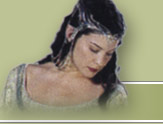|
SIDE OF INNER GOWN -
PLAIN FABRIC VISIBLE
Although a rich looking corded lace fabric
was used on the upper bodice and sleeves of the inner gown,
it was not used to construct the entire gown. If you look
through the large arm hole of the outer gown you can see a
bit of plain fabric in the back (this fabric appeared to have
a bit of a sheen to it and may have been silk, or even
some kind of polyester blend).
Not only is it more affordable to construct
the hidden portion of the gown's body in a plain fabric, it
probably also allows the outer velvet gown to have a clean
smooth drape. All the corded lace and pearls could have looked
quite lumpy underneath the outer velvet gown and prevented
it from hanging freely.
The color of this plain fabric is debatable.
When I originally saw the plain fabric peeking through the
arm cycle at the exhibit, it looked like it might be green
(it was in a shadow and difficult to see). However, in a few
photos published on the web the fabric looked white (see top
photos at the left). In yet another photo published on the
web the fabric looks green (view bottom left photo). It's
possible that it is a light green fabric with a sheen that
is reflecting the light to look white in some photos.
No side seam was visible under the arm
of the inner gown. I suspect this is because the decorative
lace fabric was applied as an overlay in one piece to prevent
the less expensive plain white fabric of the gown from showing.
The under gown probably actually does have side seams that
join the front and back white panels of fabric to form the
gown.
|

